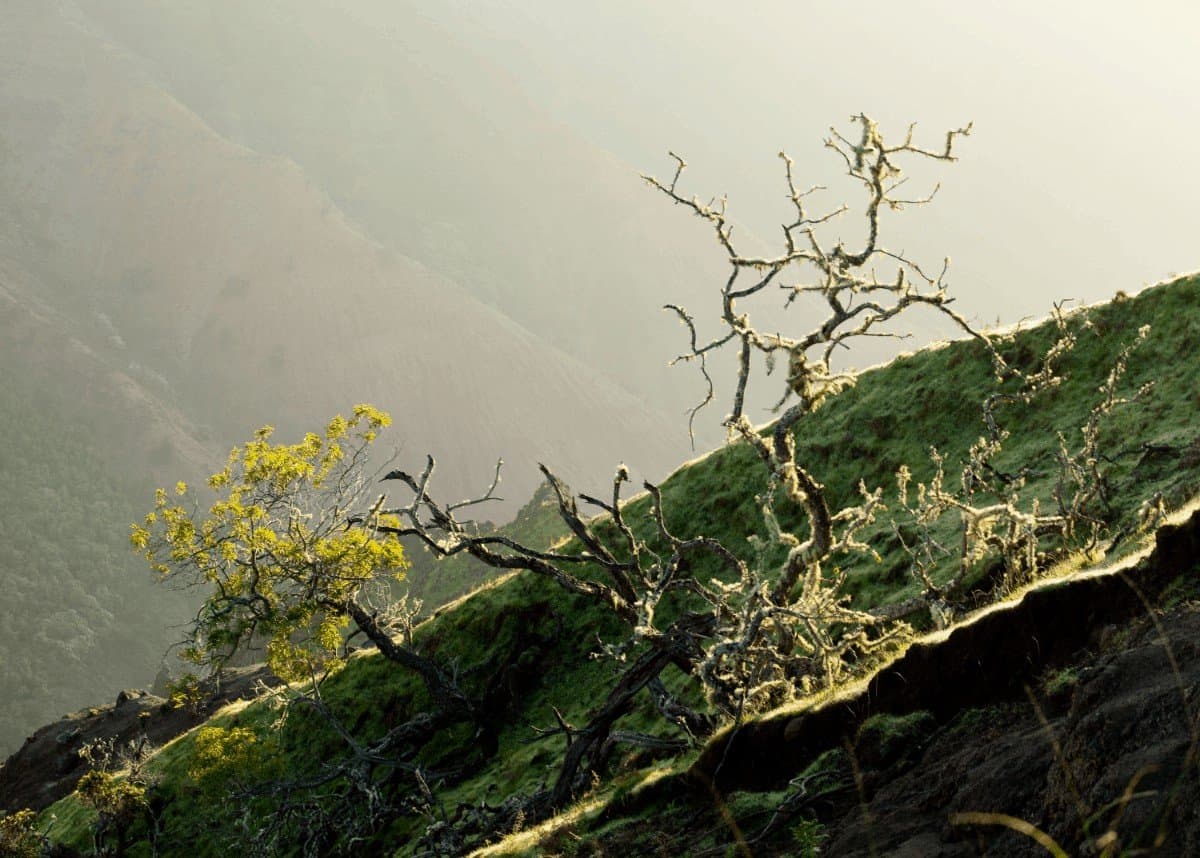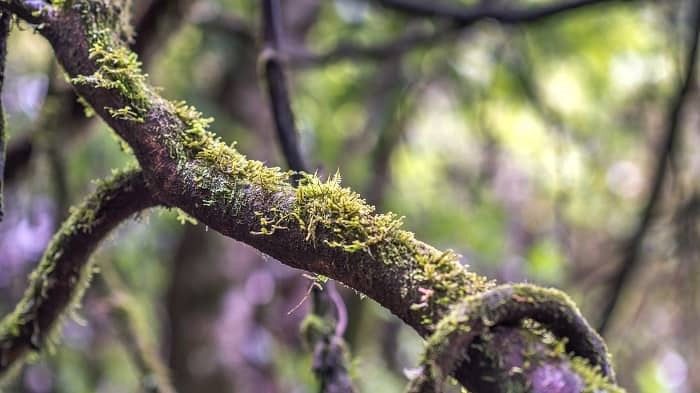Last Updated on December 30, 2021 by
A major problem for gardeners and arborists is the development of lichen on trees. You are no doubt familiar with lichen, even if you don’t know the actual term. Lichen is that strange, hard growth that grows along the bark of trees and nearby surfaces in a rainbow of blue, green, white, and gray.
Lichen doesn’t physically harm trees, but it can be a pain for anyone who wants to keep their trees beautiful and unmarred by this strange substance. After all, it tends to give trees an almost rotting effect. If it is growing on any of your trees – deciduous, coniferous, fruit, etc. – consider one of these methods to get rid of it for good.
How to Get Rid of Lichen on Trees
It can be frustrating to have watched a tree sprout from a small seed into a beautiful tree, only to be confronted with the reality of lichen. Lichen often forms patches all over the bark, covering the tree with green, brown, or even blue growths that are alien to everything a gardener knows. This often leads novices to go into damage control mode, followed by a frenzy of “burn it all to the ground” out of fear that the lichen will spread. Thankfully, this is not the case.
While lichen keeps itself close to tree bark, there are several ways to get rid of lichen on trees without harming the bark underneath. These methods work by targeting the structure of the lichen itself, which is one of the most unusual in the plant kingdom.
What Are Tree Lichens?
Lichen is a unique lifeform constructed by two others: fungus and algae. Sometimes a cyanobacterium can take the place of the algae if it’s not available. These organisms form a symbiotic relationship, meaning they benefit one another and use each other to survive. This symbiotic relationship creates a vegetative body called a thallus, which is the lichen you see on the trees.
The thallus’s structure is composed mostly of fungal fibers. The fungus cannot make its own nutrition, so it protects an interior deposit of algae or cyanobacteria, which produces food through photosynthesis. The result is the strange lichen you see growing on your trees.
Lichen lacks most of the elements gardeners associated with plants. There are no stems, leaves, water-storing waxy cuticles, or roots. Lichen doesn’t even feed on the tree bark, although many people think so. Instead, trees just serve as a convenient surface for the fungus and algae or cyanobacteria to grow undisturbed by the chaos on the ground.
So, when you want to remove lichen from your trees, it’s important to focus on using methods that work on fungi, algae, and similar structures. The methods below are some of the best for gardeners of all experience levels.
The Scrubbing Method
If you’re worried about damaging your tree by using sprays or chemicals on the lichen, consider avoiding them all together with the scrubbing method. The majority of lichens are harmless, and since they are made of fungi, algae, or cyanobacteria, a little soap and water are all you need. Lightly scrub the solution over the lichen, and it will fall off.
Be careful not to scrub too hard, though. If you do, you can accidentally take some of the bark off of the tree as well. If you’re not sure what kind of soap to use, the best solution is dish soap.
Lime Sulfur and Copper Sulfate
Lime sulfur is a material that should only be used by experienced gardeners. It is a white substance composed of calcium hydroxide and sulfur, a potent combination. It can only be used on dormant plants, as the powerful life will destroy any leaves, stems, or roots it touches. This is great news because it eliminates lichen, but bad news if you accidentally spread it to another part of the tree.
If you want to use lime sulfur, consider investing in a horticultural dormant spray that mixes it with oil. It can be applied directly to the lichen and will eat right through it. It can also be used to attack a variety of other problems, including black rot, black spot, blights, powdery mildew, and anthracnose.
Similar to lime sulfur is copper sulfate, which can be sprayed on lichen during late spring through early fall. Copper sulfate is another potentially toxic substance, so keep it away from leaves, stems, and roots. It also doesn’t work in cooler weather, so it must be sprayed in warm weather like the summer.
Branch Thinning
If you’re unsure about the best way to get rid of lichen, or simply don’t want to use soap or harsh elements near your trees, consider branch thinning. Lichen grows best in cool, moist areas that only receive sun part of the time. If the side of your tree has lichen on one side of it, consider thinning the branches above the area so more sunshine leaks through. It would also be a good idea to remove regular water sources, like a sprinkler, if they keep hitting that side of the tree.
Changing the environment of the tree and its lichen will take some extra time and effort, but it will help prevent the growth from coming back in the future.
Conclusion
If you are struggling with lichen in your garden, you’re not alone. These fungi/algae/cyanobacteria combinations grow in cold climates all around the globe and seem to enjoy trees because they provide an ideal location away from the dangers of ground. Plus, the branches of the trees offer protection from the warmth and sunlight that the fungi dislike.
If anyone of these methods does not work for you, consider trying them in descending order. So, wash with soap and water first. Follow up with lime sulfate or copper sulfate. If you’re still struggling, it might be time to prune and rearrange the yard.
Don’t let the lichen get the best of you. It’s a delicate symbiotic relationship, and it will be easy for you to disrupt it.
FAQs
Should you remove lichen from trees?
In many cases, lichen is a part of the tree. Removal of lichen from trees can cause the growth and decline of the trees.
In some cases, it's better for the health of trees to remove lichen from them when it becomes a threat. It's important not to take matters into your own hands and always make sure that you consult with your local authorities before doing anything like this.
Are lichens harmful to trees?
Lichens are not harmful to trees. They actually make their leaves and bark healthier by providing shade and nutrients.
A lichen is a symbiotic organism that grows on the surface of other plants, typically trees, rocks, or buildings. Although they are not harmful to trees, they can reduce tree growth by taking away light or moisture.
What causes lichens to grow on trees?
Lichens grow in areas with a lot of moisture as well as cool temperatures. They can also be found on waterfalls and damp cliffs. Lichens usually form on the bark of tree trunks or large branches where they are supported by the tree's strength and exposure to air. The best time for lichen growth is during springtime when the tree is coming out of winter dormancy which means it has more nutrients to share with their friends!
How do you get rid of lichen on trees naturally?
Lichen is a type of fungus that is found on trees. It can be problematic for the tree because it can kill a tree if untreated.
There are many ways to get rid of lichen from a tree naturally. The most popular way is to scrape off the lichen with your fingernails and then scrub the area with soap and water until there are no signs of it left.
How do you control lichen?
When you have lichen or mold infestation in your home or business, it’s very important to know how to control lichen as soon as possible so that it doesn’t spread and become a bigger problem for you.
Lichen are a very hardy organism that can be found on rocks and trees in almost any climate worldwide. They get their nutrients from the air and the soil they grow on but they also feed off of other plants around them as well. They are especially difficult to control because they coat themselves in various mosses or algae so that humans cannot see them or eliminate them easily.
When it comes to controlling lichen, there are a few methods that you can try. The easiest of them is to use a mix of bleach and water. Another method is to use bleach and vinegar.
There are two other ways to control lichen: physically and chemically.
The first way is to physically remove it from its place by scraping it off with a metal shovel or knocking it off with a rock. The second way is to use chemicals which will kill off the lichen but won't harm the tree or plant on which the lichen grows.
Some other ways to control lichen include:
-Spotting lichens early on
-Keep your lawn mowed regularly
-Spraying pesticides regularly
amzn_assoc_placement = “adunit0”;
amzn_assoc_tracking_id = “gardeningdreams-20”;
amzn_assoc_ad_mode = “manual”;
amzn_assoc_ad_type = “smart”;
amzn_assoc_marketplace = “amazon”;
amzn_assoc_region = “US”;
amzn_assoc_linkid = “d339834990170a40c4a36970e79405a0”;
amzn_assoc_design = “in_content”;
amzn_assoc_asins = “0979200601,B00BSULSHA”;
Tony Manhart is a passionate gardener who has been tending to gardens for over 20 years. He takes pride in creating beautiful outdoor spaces with plants, trees, and shrubs that can thrive in any environment. He loves to share his knowledge with others and has taught classes on gardening basics and advanced techniques. He is committed to sustainability, using natural and organic methods to create and maintain gardens. He also works with local organizations to create green spaces for communities. When he’s not gardening, Tony enjoys hiking, reading, and spending time with his family.



